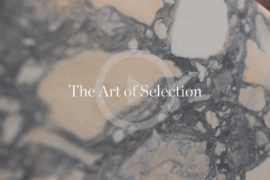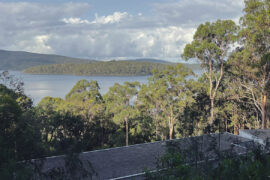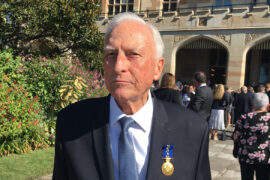In this comment piece, Indigenous Creative Lead at Balarinji, Johnny Bridges, discusses designing with Country and the environment.

'Goanna and Snake Story' by Marcus Ferguson and Oral Roberts for Transport for NSW Aboriginal Art Trail.
September 3rd, 2024
Traditionally, designers have prioritised design thinking based on benefits to people. However, there’s a growing shift towards considering how our environment drives the most powerful way to design places.
A designing with Country approach offers new opportunities in Australia, where our foundational Indigenous narrative can influence how designers, architects and builders think about climate, sustainability and the intimacy of built form.
Designing with Country broadens our perspective to encompass ecosystems and cultural heritage, drawing upon Indigenous knowledges and wisdom to promote the wellbeing of both people and the planet through sustainable living practices.

It’s an approach that fosters positive outcomes not only for Aboriginal and Torres Strait Islander peoples, but very significantly for the wider community. This evolution nurtures human needs by drawing on the power of the natural world and its custodians.
Country is not a Western concept; it is an Aboriginal worldview. It is nature at a deeper level, where all things are interconnected, and the spiritual underlies the physical.

Adjunct Professor Kulin/Gumbaynggirr woman Margo Neale, Principal Indigenous Advisor to the Director at the National Museum of Australia, says in her acclaimed book with Lynne Kelly, Songlines: The Power and Promise (Thames & Hudson Australia Pty Ltd, 2020):
“Everything starts and ends with Country in the Aboriginal worldview. Yet there are no endings in this worldview, nor are there any beginnings. Time and Place are infinite and everywhere. Everything is part of a continuum, an endless flow of life and ideas emanating from Country, which some refer to as the Dreaming. In the Dreaming, as in Country, there is no separation between the animate and the inanimate. Everything is living – people, animals, plants, earth, water and air. We speak of Sea, Land and Sky Country. Creator ancestors created the Country and its interface, the Dreaming. In turn, Dreaming speaks for Country which holds the law and knowledge. Country has Dreaming. Country is Dreaming. It is this oneness of all things that explains how and why Aboriginal knowledges belong to an integrated system of learning.”
Related: Q&A with Balarinji

Designing with Country is translating deep knowledge from Country and integrating it into design. It’s design thinking beyond aesthetics and can contribute throughout project areas such as masterplanning, environmental considerations, and health and social outcomes for end-users.
This approach represents significant innovation in the design sector; it’s a disruptor and an exciting opportunity to explore and celebrate a shared cultural identity.
With any new approach, the challenge of designing with Country comes not in its philosophy but in how to apply it. It is not only intention, but a professional competency that we’ve developed at Balarinji across four decades. Successful designing with Country can only be achieved through authentic and meaningful co-design methodologies with Aboriginal and Torres Strait Islander peoples; those who are the experts of Country, the Traditional Custodians who are from that specific Country or connected to it through kinship or community.

In a designing with Country approach, the co-design process establishes the cultural narrative of the project by drawing out Place-based knowledge, spirituality, protocols, history, culture and contemporary stories to be interpreted for design thinking.
This style of co-design is groundbreaking and goes beyond traditional methods of consultation for approvals or information. Instead, it deeply engages Aboriginal and Torres Strait Islander knowledge holders in the design process. It translates authentic, cultural narratives from Country into contemporary design that celebrates an incredibly unique Australian identity.
The shift towards designing with Country thinking is just beginning to disrupt the design sector. It’s early days when it comes to the possibilities and the long-term positive impacts it could have on a more inspired and inclusive identity for our nation.
I would love to see a designing with Country framework become the Australian standard for architecture and design. It signifies a new way forward, one that celebrates belonging, optimism and caring for Country through the powerful lens of design.
Balarinji
balarinji.com.au

INDESIGN is on instagram
Follow @indesignlive
A searchable and comprehensive guide for specifying leading products and their suppliers
Keep up to date with the latest and greatest from our industry BFF's!

CDK Stone’s Natasha Stengos takes us through its Alexandria Selection Centre, where stone choice becomes a sensory experience – from curated spaces, crafted details and a colour-organised selection floor.

Welcomed to the Australian design scene in 2024, Kokuyo is set to redefine collaboration, bringing its unique blend of colour and function to individuals and corporations, designed to be used Any Way!

London-based design duo Raw Edges have joined forces with Established & Sons and Tongue & Groove to introduce Wall to Wall – a hand-stained, “living collection” that transforms parquet flooring into a canvas of colour, pattern, and possibility.

With projects shortlisted for Habitus House of the Year 2025, Anthony Gill and Jason Gibney join the podcast to discuss the state of housing in Australia today.

Making a splash on the hair spa scene, the latest project from X + O makes a little slice of Japan right at home in suburban Melbourne.
The internet never sleeps! Here's the stuff you might have missed

The Australian marketing and advertising community is mourning the loss of Murray Robert Pope, a distinguished marketing strategist and community leader who passed away peacefully at his home on October 20th, 2025.

Gray Puksand’s adaptive reuse of former Melbourne office into Hester Hornbrook Academy’s new City Campus shows how architecture can support wellbeing, connection and community.

Rising above the new Sydney Metro Gadigal Station on Pitt Street, Investa’s Parkline Place is redefining the office property aesthetic.